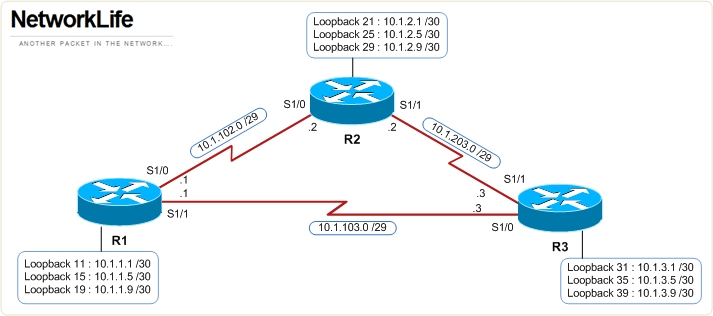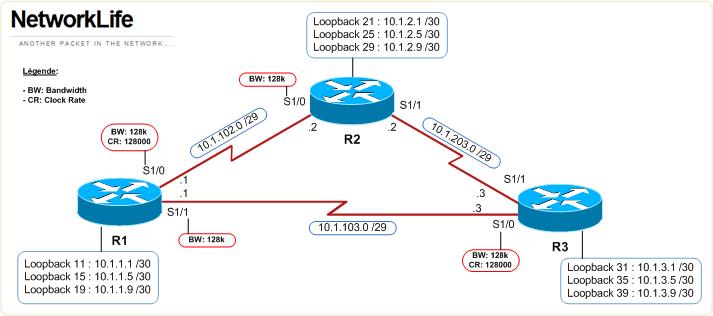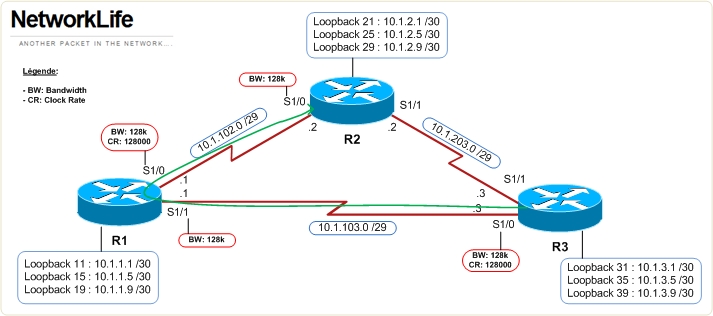BSCI: LAB EIGRP – Load Balancing
Bienvenue sur le deuxième Lab BSCI sur EIGRP et le Load-balancing, (partage de charge pour les Français).
Nous allons voir le Load balancing avec des Equal-costs, et des Unequal-costs, Enjoy !
Voici la topo:

Dynagen
#### # # Author: Benoit GONCALVES # Course: BSCI - EIGRP - Load balancing # Version: 1.1 # #### autostart = True [localhost:7200] [[7200]] [[ROUTER R1]] image = c7200-adventerprisek9-mz.124-15.T6.bin cnfg = R1.txt npe = npe-400 ram = 160 nvram = 256 mmap = False console = 2002 # modules/slots # cabling S1/0 = R2 S1/0 [[ROUTER R2]] image = c7200-adventerprisek9-mz.124-15.T6.bin cnfg = R2.txt npe = npe-400 ram = 160 nvram = 256 mmap = False console = 2003 # modules/slots # cabling S1/1 = R3 S1/1 [[ROUTER R3]] image = c7200-adventerprisek9-mz.124-15.T6.bin cnfg = R3.txt npe = npe-400 ram = 160 nvram = 256 mmap = False console = 2004 # modules/slots # cabling S1/0 = R1 S1/1
R1
hostname R1 ! interface Loopback 11 ip address 10.1.1.1 255.255.255.252 ! interface Loopback 15 ip address 10.1.1.5 255.255.255.252 ! interface Loopback 19 ip address 10.1.1.9 255.255.255.252 ! ! interface Serial 1/0 description R1 -> R2 bandwidth 64 ip address 10.1.102.1 255.255.255.248 clockrate 64000 no shutdown ! interface Serial 1/1 description R1 -> R3 bandwidth 64 ip address 10.1.103.1 255.255.255.248 clockrate 64000 no shutdown ! router eigrp 100 network 10.0.0.0 ! end
R2
hostname R2 ! interface Loopback 21 ip address 10.1.2.1 255.255.255.252 ! interface Loopback 25 ip address 10.1.2.5 255.255.255.252 ! interface Loopback 29 ip address 10.1.2.9 255.255.255.252 ! ! interface Serial 1/0 description R2 -> R1 bandwidth 64 ip address 10.1.102.2 255.255.255.248 clockrate 64000 no shutdown ! interface Serial 1/1 description R2 -> R3 bandwidth 64 ip address 10.1.203.2 255.255.255.248 clockrate 64000 no shutdown ! router eigrp 100 network 10.0.0.0 ! end
R3
hostname R3 ! interface Loopback 31 ip address 10.1.3.1 255.255.255.252 ! interface Loopback 35 ip address 10.1.3.5 255.255.255.252 ! interface Loopback 39 ip address 10.1.3.9 255.255.255.252 ! ! interface Serial 1/0 description R3 -> R1 bandwidth 64 ip address 10.1.103.3 255.255.255.248 clockrate 64000 no shutdown ! interface Serial 1/1 description R3 -> R2 bandwidth 64 ip address 10.1.203.3 255.255.255.248 clockrate 64000 no shutdown ! router eigrp 100 network 10.0.0.0 ! end
Une petite vue de la table de routage de R1:
R1#sh ip route
Codes: C - connected, S - static, R - RIP, M - mobile, B - BGP
D - EIGRP, EX - EIGRP external, O - OSPF, IA - OSPF inter area
N1 - OSPF NSSA external type 1, N2 - OSPF NSSA external type 2
E1 - OSPF external type 1, E2 - OSPF external type 2
i - IS-IS, su - IS-IS summary, L1 - IS-IS level-1, L2 - IS-IS level-2
ia - IS-IS inter area, * - candidate default, U - per-user static route
o - ODR, P - periodic downloaded static route
Gateway of last resort is not set
10.0.0.0/8 is variably subnetted, 12 subnets, 2 masks
D 10.1.3.8/30 [90/40640000] via 10.1.103.3, 01:06:49, Serial1/1
D 10.1.2.8/30 [90/40640000] via 10.1.102.2, 01:06:49, Serial1/0
C 10.1.1.8/30 is directly connected, Loopback19
D 10.1.3.0/30 [90/40640000] via 10.1.103.3, 01:06:49, Serial1/1
D 10.1.2.0/30 [90/40640000] via 10.1.102.2, 01:06:49, Serial1/0
C 10.1.1.0/30 is directly connected, Loopback11
D 10.1.3.4/30 [90/40640000] via 10.1.103.3, 01:06:49, Serial1/1
D 10.1.2.4/30 [90/40640000] via 10.1.102.2, 01:06:49, Serial1/0
C 10.1.1.4/30 is directly connected, Loopback15
C 10.1.103.0/29 is directly connected, Serial1/1
C 10.1.102.0/29 is directly connected, Serial1/0
D 10.1.203.0/29 [90/41024000] via 10.1.103.3, 01:06:49, Serial1/1
[90/41024000] via 10.1.102.2, 01:06:49, Serial1/0
Ainsi que la table de voisinage de nos 3 routeurs:
R1#sh ip ei nei
IP-EIGRP neighbors for process 100
H Address Interface Hold Uptime SRTT RTO Q Seq
(sec) (ms) Cnt Num
1 10.1.103.3 Se1/1 11 01:09:21 432 2592 0 8
0 10.1.102.2 Se1/0 12 01:10:12 369 2280 0 10
R2#sh ip ei nei
IP-EIGRP neighbors for process 100
H Address Interface Hold Uptime SRTT RTO Q Seq
(sec) (ms) Cnt Num
1 10.1.203.3 Se1/1 12 01:09:26 301 2280 0 6
0 10.1.102.1 Se1/0 10 01:10:17 952 5000 0 9
R3#sh ip ei nei
IP-EIGRP neighbors for process 100
H Address Interface Hold Uptime SRTT RTO Q Seq
(sec) (ms) Cnt Num
1 10.1.203.2 Se1/1 14 01:09:31 352 2280 0 11
0 10.1.103.1 Se1/0 10 01:09:31 380 2280 0 10
Table topologique
La table topologique contient une vue de la topologie avoisinante, et nous pouvons voir toutes les routes possibles,
dont les “successor routes”.
R3#sh ip eigrp topology
IP-EIGRP Topology Table for AS(100)/ID(10.1.3.9)
Codes: P - Passive, A - Active, U - Update, Q - Query, R - Reply,
r - reply Status, s - sia Status
P 10.1.3.8/30, 1 successors, FD is 128256
via Connected, Loopback39
P 10.1.2.8/30, 1 successors, FD is 40640000
via 10.1.203.2 (40640000/128256), Serial1/1
P 10.1.1.8/30, 1 successors, FD is 40640000
via 10.1.103.1 (40640000/128256), Serial1/0
P 10.1.3.0/30, 1 successors, FD is 128256
via Connected, Loopback31
P 10.1.2.0/30, 1 successors, FD is 40640000
via 10.1.203.2 (40640000/128256), Serial1/1
P 10.1.1.0/30, 1 successors, FD is 40640000
via 10.1.103.1 (40640000/128256), Serial1/0
P 10.1.3.4/30, 1 successors, FD is 128256
via Connected, Loopback35
P 10.1.2.4/30, 1 successors, FD is 40640000
via 10.1.203.2 (40640000/128256), Serial1/1
P 10.1.1.4/30, 1 successors, FD is 40640000
via 10.1.103.1 (40640000/128256), Serial1/0
P 10.1.103.0/29, 1 successors, FD is 40512000
via Connected, Serial1/0
P 10.1.102.0/29, 2 successors, FD is 41024000
via 10.1.103.1 (41024000/40512000), Serial1/0
via 10.1.203.2 (41024000/40512000), Serial1/1
P 10.1.203.0/29, 1 successors, FD is 40512000
via Connected, Serial1/1
Le plus impotant dans cette table topologique se situe à la fin, avec les 2 successors en etat passif.
R1 et R2 “advertisent” (annoncent) leurs subnet 10.1.102.0/30. Les deux routes ayant la même distance (40512000) elle sont toutes les deux installées dans la table topologique.
40512000 est le résultat de la métrique en fonction du chemin de destination du réseau 10.1.102.0/30.
Le calcul de la métrique se fait grâce à la formule suivante: (mais j’y reviendrais dans un prochain article sur les fondamentaux d’EIGRP):
![]()
–
–
Avec les valeurs suivantes:
- min(bandwidth) est la bande passante minimale le long du chemin, exprimée en kbit/s
- les délais sont exprimés en microsecondes.
R3#sh ip eigrp topology 10.1.102.0/29
IP-EIGRP (AS 100): Topology entry for 10.1.102.0/29
State is Passive, Query origin flag is 1, 2 Successor(s), FD is 41024000
Routing Descriptor Blocks:
!Chemin passant par R1
10.1.103.1 (Serial1/0), from 10.1.103.1, Send flag is 0x0
Composite metric is (41024000/40512000), Route is Internal
Vector metric:
Minimum bandwidth is 64 Kbit
Total delay is 40000 microseconds
Reliability is 255/255
Load is 1/255
Minimum MTU is 1500
Hop count is 1
!Chemin passant par R2
10.1.203.2 (Serial1/1), from 10.1.203.2, Send flag is 0x0
Composite metric is (41024000/40512000), Route is Internal
Vector metric:
Minimum bandwidth is 64 Kbit
Total delay is 40000 microseconds
Reliability is 255/255
Load is 1/255
Minimum MTU is 1500
Hop count is 1
Les points importants de la vue ci-dessus sont:
- Bandwidth metric: bande passante minimum utilisée sur ce lien (ici 64k).
- Delay: Délai TOTAL sur ce lien (ici 40000 micro sec.)
- Load : Charge du lien (255/255 = Full, ici il n’est pas utilisé)
- MTU: le MTU le plus petit présent sur ce lien.
- Hop count: Le nombre de saut (routeurs/Niveau 3) jusqu’au réseau distant
Load balancing Equal-Cost
EIGRP effectue un partage de charge entre R1 et R2 pour le réseau 10.1.102.0/30.
Comme nous venons de le voir, nous avons deux “coûts” égaux entre ces deux chemins.
R3#debug ip packet IP packet debugging is on R3# R3#ping 10.1.102.1 Type escape sequence to abort. Sending 5, 100-byte ICMP Echos to 10.1.102.1, timeout is 2 seconds: !!!!! Success rate is 100 percent (5/5), round-trip min/avg/max = 1/3/4 ms R3# *Jan 13 18:39:01.579: IP: tableid=0, s=10.1.103.3 (local), d=10.1.102.1 (Serial1/0), routed via RIB *Jan 13 18:39:01.583: IP: s=10.1.103.3 (local), d=10.1.102.1 (Serial1/0), len 100, sending [...] *Jan 13 18:39:01.747: IP: tableid=0, s=10.1.102.1 (Serial1/0), d=10.1.103.3 (Serial1/0), routed via RIB *Jan 13 18:39:01.751: IP: s=10.1.102.1 (Serial1/0), d=10.1.103.3 (Serial1/0), len 100, rcvd 3 [...] *Jan 13 18:39:01.763: IP: tableid=0, s=10.1.203.3 (local), d=10.1.102.1 (Serial1/1), routed via RIB *Jan 13 18:39:01.763: IP: s=10.1.203.3 (local), d=10.1.102.1 (Serial1/1), len 100, sending [...] *Jan 13 18:39:02.055: IP: tableid=0, s=10.1.102.1 (Serial1/1), d=10.1.203.3 (Serial1/1), routed via RIB *Jan 13 18:39:02.059: IP: s=10.1.102.1 (Serial1/1), d=10.1.203.3 (Serial1/1), len 100, rcvd 3 [...] *Jan 13 18:39:02.067: IP: tableid=0, s=10.1.103.3 (local), d=10.1.102.1 (Serial1/0), routed via RIB *Jan 13 18:39:02.071: IP: s=10.1.103.3 (local), d=10.1.102.1 (Serial1/0), len 100, sending [...] *Jan 13 18:39:02.187: IP: tableid=0, s=10.1.102.1 (Serial1/0), d=10.1.103.3 (Serial1/0), routed via RIB *Jan 13 18:39:02.191: IP: s=10.1.102.1 (Serial1/0), d=10.1.103.3 (Serial1/0), len 100, rcvd 3 [...] *Jan 13 18:39:02.203: IP: tableid=0, s=10.1.203.3 (local), d=10.1.102.1 (Serial1/1), routed via RIB *Jan 13 18:39:02.207: IP: s=10.1.203.3 (local), d=10.1.102.1 (Serial1/1), len 100, sending [...] *Jan 13 18:39:02.555: IP: tableid=0, s=10.1.102.1 (Serial1/1), d=10.1.203.3 (Serial1/1), routed via RIB *Jan 13 18:39:02.559: IP: s=10.1.102.1 (Serial1/1), d=10.1.203.3 (Serial1/1), len 100, rcvd 3 [...]
Nous voyons bien ci-dessus le partage de charge fait entre R1 (Serial1/0) et R2 (Serial1/1).
Unequal-Cost Load Balancing
R3#sh ip ei topo 10.1.2.0/30
*Jan 14 10:26:54.867: %SYS-5-CONFIG_I: Configured from console by console
IP-EIGRP (AS 100): Topology entry for 10.1.2.0/30
State is Passive, Query origin flag is 1, 1 Successor(s), FD is 40640000
Routing Descriptor Blocks:
10.1.203.2 (Serial1/1), from 10.1.203.2, Send flag is 0x0
Composite metric is (40640000/128256), Route is Internal
Vector metric:
Minimum bandwidth is 64 Kbit
Total delay is 25000 microseconds
Reliability is 255/255
Load is 1/255
Minimum MTU is 1500
Hop count is 1
10.1.103.1 (Serial1/0), from 10.1.103.1, Send flag is 0x0
Composite metric is (41152000/40640000), Route is Internal
Vector metric:
Minimum bandwidth is 64 Kbit
Total delay is 45000 microseconds
Reliability is 255/255
Load is 1/255
Minimum MTU is 1500
Hop count is 2
Nous allons changer la valeur des bandwidth comme suit:

Voici comment effectuer ce changement:
R1(config)#interface serial 1/0 R1(config-if)#bandwidth 128 R1(config-if)#clock rate 128000 R1(config-if)#interface serial 1/1 R1(config-if)#bandwidth 128 ! R2(config)#interface serial 1/0 R2(config-if)#bandwidth 128 ! R3(config)#interface serial 1/0 R3(config-if)#clock rate 128000 R3(config-if)#bandwidth 128
Et maintenant, voici la nouvelle topologie, vue par EIGRP.
Le chemin préféré de R3 pour aller vers R2 est R1, car deux saut de 128k vont plus vites qu’un saut de 64 !!
R3#sh ip ei topo 10.1.2.0/30
IP-EIGRP (AS 100): Topology entry for 10.1.2.0/30
State is Passive, Query origin flag is 1, 1 Successor(s), FD is 21152000
Routing Descriptor Blocks:
10.1.103.1 (Serial1/0), from 10.1.103.1, Send flag is 0x0
Composite metric is (21152000/20640000), Route is Internal
Vector metric:
Minimum bandwidth is 128 Kbit
Total delay is 45000 microseconds
Reliability is 255/255
Load is 1/255
Minimum MTU is 1500
Hop count is 2
10.1.203.2 (Serial1/1), from 10.1.203.2, Send flag is 0x0
Composite metric is (40640000/128256), Route is Internal
Vector metric:
Minimum bandwidth is 64 Kbit
Total delay is 25000 microseconds
Reliability is 255/255
Load is 1/255
Minimum MTU is 1500
Hop count is 1

–
–
–
–
Nous allons maintenant manipuler la Variance d’EIGRP.
Variance : Variance x FD (Feasible Distance pour chaque route dans la table de routage). Par exemple avec une Variance de 2, si nous avons deux chemins pour une destination, si 25 paquets sont envoyés sur une interface, 50 seront envoyés sur l’autre. ou Si 64 paquets sont envoyés sur une interface, 128 seront envoyés sur l’autre… etc.
Avant d’effectuer la manipulation, on garde la table de routage actuelle du R3
R3#sh ip route eigrp
10.0.0.0/8 is variably subnetted, 12 subnets, 2 masks
D 10.1.2.8/30 [90/21152000] via 10.1.103.1, 00:18:16, Serial1/0
D 10.1.1.8/30 [90/20640000] via 10.1.103.1, 00:18:16, Serial1/0
D 10.1.2.0/30 [90/21152000] via 10.1.103.1, 00:18:16, Serial1/0
D 10.1.1.0/30 [90/20640000] via 10.1.103.1, 00:18:16, Serial1/0
D 10.1.2.4/30 [90/21152000] via 10.1.103.1, 00:18:16, Serial1/0
D 10.1.1.4/30 [90/20640000] via 10.1.103.1, 00:18:16, Serial1/0
D 10.1.102.0/29 [90/21024000] via 10.1.103.1, 00:18:16, Serial1/0
Maintenant, on change la variance du process EIGRP à 2:
R3#deb ip eigrp 100 IP-EIGRP Route Events debugging is on R3#conf t Enter configuration commands, one per line. End with CNTL/Z. R3(config)#router eigrp 100 R3(config-router)#variance 2 *Jan 14 10:51:05.023: IP-EIGRP(Default-IP-Routing-Table:100): 10.1.3.8/30 routing table not updated thru 10.1.203.2 *Jan 14 10:51:05.027: IP-EIGRP(Default-IP-Routing-Table:100): route installed for 10.1.2.8 () *Jan 14 10:51:05.031: IP-EIGRP(Default-IP-Routing-Table:100): route installed for 10.1.2.8 () *Jan 14 10:51:05.035: IP-EIGRP(Default-IP-Routing-Table:100): route installed for 10.1.1.8 () *Jan 14 10:51:05.039: IP-EIGRP(Default-IP-Routing-Table:100): 10.1.1.8/30 routing table not updated thru 10.1.203.2 *Jan 14 10:51:05.043: IP-EIGRP(Default-IP-Routing-Table:100): 10.1.3.0/30 routing table not updated thru 10.1.203.2 *Jan 14 10:51:05.047: IP-EIGRP(Default-IP-Routing-Table:100): route installed for 10.1.2.0 () *Jan 14 10:51:05.051: IP-EIGRP(Default-IP-Routing-Table:100): route installed for 10.1.2.0 () *Jan 14 10:51:05.055: IP-EIGRP(Default-IP-Routing-Table:100): route installed for 10.1.1.0 () *Jan 14 10:51:05.059: IP-EIGRP(Default-IP-Routing-Table:100): 10.1.1.0/30 routing table not updated thru 10.1.203.2 *Jan 14 10:51:05.063: IP-EIGRP(Default-IP-Routing-Table:100): 10.1.3.4/30 routing table not updated thru 10.1.203.2 *Jan 14 10:51:05.067: IP-EIGRP(Default-IP-Routing-Table:100): route installed for 10.1.2.4 () *Jan 14 10:51:05.071: IP-EIGRP(Default-IP-Routing-Table:100): route installed for 10.1.2.4 () *Jan 14 10:51:05.075: IP-EIGRP(Default-IP-Routing-Table:100): route installed for 10.1.1.4 () *Jan 14 10:51:05.079: IP-EIGRP(Default-IP-Routing-Table:100): 10.1.1.4/30 routing table not updated thru 10.1.203.2 *Jan 14 10:51:05.079: IP-EIGRP(Default-IP-Routing-Table:100): 10.1.103.0/29 routing table not updated thru 10.1.203.2 *Jan 14 10:51:05.079: IP-EIGRP(Default-IP-Routing-Table:100): route installed for 10.1.102.0 () *Jan 14 10:51:05.079: IP-EIGRP(Default-IP-Routing-Table:100): route installed for 10.1.102.0 ()
Voyons ce qui à changé:
R3#sh ip route
*Jan 14 10:52:38.103: %SYS-5-CONFIG_I: Configured from console by consoleroute
Codes: C - connected, S - static, R - RIP, M - mobile, B - BGP
D - EIGRP, EX - EIGRP external, O - OSPF, IA - OSPF inter area
N1 - OSPF NSSA external type 1, N2 - OSPF NSSA external type 2
E1 - OSPF external type 1, E2 - OSPF external type 2
i - IS-IS, su - IS-IS summary, L1 - IS-IS level-1, L2 - IS-IS level-2
ia - IS-IS inter area, * - candidate default, U - per-user static route
o - ODR, P - periodic downloaded static route
Gateway of last resort is not set
10.0.0.0/8 is variably subnetted, 12 subnets, 2 masks
C 10.1.3.8/30 is directly connected, Loopback39
D 10.1.2.8/30 [90/40640000] via 10.1.203.2, 00:01:34, Serial1/1
[90/21152000] via 10.1.103.1, 00:01:34, Serial1/0
D 10.1.1.8/30 [90/20640000] via 10.1.103.1, 00:01:34, Serial1/0
C 10.1.3.0/30 is directly connected, Loopback31
D 10.1.2.0/30 [90/40640000] via 10.1.203.2, 00:01:34, Serial1/1
[90/21152000] via 10.1.103.1, 00:01:34, Serial1/0
D 10.1.1.0/30 [90/20640000] via 10.1.103.1, 00:01:34, Serial1/0
C 10.1.3.4/30 is directly connected, Loopback35
D 10.1.2.4/30 [90/40640000] via 10.1.203.2, 00:01:34, Serial1/1
[90/21152000] via 10.1.103.1, 00:01:34, Serial1/0
D 10.1.1.4/30 [90/20640000] via 10.1.103.1, 00:01:34, Serial1/0
C 10.1.103.0/29 is directly connected, Serial1/0
D 10.1.102.0/29 [90/41024000] via 10.1.203.2, 00:01:35, Serial1/1
[90/21024000] via 10.1.103.1, 00:01:35, Serial1/0
C 10.1.203.0/29 is directly connected, Serial1/1
Ces routes aux coûts inégaux se voient également dans la table topologique EIGRP, même
s’ils ne sont pas considérés comme des successeurs (la distance n’est pas plus petite que la feasible distance).
On vérifie celà avec un “show ip eigrp topology”.
R3#sh ip ei topo
IP-EIGRP Topology Table for AS(100)/ID(10.1.3.9)
Codes: P - Passive, A - Active, U - Update, Q - Query, R - Reply,
r - reply Status, s - sia Status
P 10.1.3.8/30, 1 successors, FD is 128256
via Connected, Loopback39
P 10.1.2.8/30, 1 successors, FD is 21152000
via 10.1.103.1 (21152000/20640000), Serial1/0
via 10.1.203.2 (40640000/128256), Serial1/1
P 10.1.1.8/30, 1 successors, FD is 20640000
via 10.1.103.1 (20640000/128256), Serial1/0
P 10.1.3.0/30, 1 successors, FD is 128256
via Connected, Loopback31
P 10.1.2.0/30, 1 successors, FD is 21152000
via 10.1.103.1 (21152000/20640000), Serial1/0
via 10.1.203.2 (40640000/128256), Serial1/1
P 10.1.1.0/30, 1 successors, FD is 20640000
via 10.1.103.1 (20640000/128256), Serial1/0
P 10.1.3.4/30, 1 successors, FD is 128256
via Connected, Loopback35
P 10.1.2.4/30, 1 successors, FD is 21152000
via 10.1.103.1 (21152000/20640000), Serial1/0
via 10.1.203.2 (40640000/128256), Serial1/1
P 10.1.1.4/30, 1 successors, FD is 20640000
via 10.1.103.1 (20640000/128256), Serial1/0
P 10.1.103.0/29, 1 successors, FD is 20512000
via Connected, Serial1/0
P 10.1.102.0/29, 1 successors, FD is 21024000
via 10.1.103.1 (21024000/20512000), Serial1/0
via 10.1.203.2 (41024000/20512000), Serial1/1
P 10.1.203.0/29, 1 successors, FD is 40512000
via Connected, Serial1/1
L’équilibrage de charge sur des liaisons série se produit en utilisant des blocs de paquets, leurs nombre est enregistré dans les informations de la table de routage.
Utilisez le “show ip route 10.1.2.0” pour obtenir une vue détaillée de la façon dont le partage de traffic se produit.
R3#sh ip route 10.1.2.0
Routing entry for 10.1.2.0/30
Known via "eigrp 100", distance 90, metric 21152000, type internal
Redistributing via eigrp 100
Last update from 10.1.203.2 on Serial1/1, 00:07:01 ago
Routing Descriptor Blocks:
10.1.203.2, from 10.1.203.2, 00:07:01 ago, via Serial1/1
Route metric is 40640000, traffic share count is 25
Total delay is 25000 microseconds, minimum bandwidth is 64 Kbit
Reliability 255/255, minimum MTU 1500 bytes
Loading 1/255, Hops 1
* 10.1.103.1, from 10.1.103.1, 00:07:01 ago, via Serial1/0
Route metric is 21152000, traffic share count is 48
Total delay is 45000 microseconds, minimum bandwidth is 128 Kbit
Reliability 255/255, minimum MTU 1500 bytes
Loading 1/255, Hops 2
Nous pouvons voir que 25 paquets sont routés vers R2 pour 48 paquets routés vers R1.
2 Comments
Comments are Disabled



Salut,
Dans ta conf originale, il te manque routeur eigrp bla blah blah …
Amicalement,
Christophe
Ouai je l’avais ajouté pendant le Lab moi même, je viens de l’ajouter aux fichiers de configs de Dynagen. Merci!